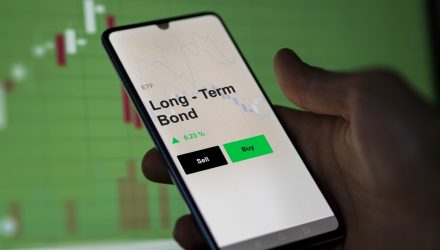Rising interest sparked elevated Treasury yields, thus representing a headwind to prices of longer-dated bonds. However, some experts believe now is the time to revisit longer-duration fares. For those looking to access the income benefits of long-dated bonds without going too far out on the duration spectrum, 10-year Treasuries could be attractive.
Enter the BondBloxx Bloomberg Ten Year Target Duration US Treasury ETF (XTEN). As its name implies, XTEN holds U.S. government debt with an average duration of 10 years. The $124.58 million ETF also offers the benefits of minimal credit risk and a 30-day SEC yield of 4.08%.
XTEN offers another perk. Although short-term bond yields are currently elevated, those yields will decline if and when the Federal Reserve lowers interest rates. A spate of maturities looms over this year. Investors holding short-term bonds or the related ETFs face the specter of reinvestment risk – reinvesting in new short-term debt with lower yields.
XTEN Could Deliver if Fed Cuts Rates
It’s possible that the Fed won’t cut rates at its March meeting. Such reductions may be pushed later into 2024. However, the relatively high starting yield an investor gets with XTEN could imply elevated odds of strong long-term outcomes.
“High-quality bond investments remain attractive. With yields on investment-grade-rated bonds still near 15-year highs, we believe investors should continue to consider intermediate- and longer-term bonds to lock in those high yields,” noted Collin Martin of Charles Schwab.
Novice bond investors might want to consider evaluating XTEN over the near term. Why? It’s typically more prudent to buy longer-dated bonds before rate cuts become official. Historical data confirms that 10-year yields typically peak and then trend lower in advance of rate cuts becoming official.
“We believe the historical relationship should hold and we expect the 10-year Treasury ultimately to decline modestly from current levels as growth and inflation slow. Investors who wait too long to consider locking in long-term yields may end up investing in lower yields than what are available today,” added Martin.
Potentially adding to the allure of XTEN is that over the Fed’s prior four tightening cycles, intermediate-term and some longer-dated bonds outperformed short-term counterparts in the year following the central bank’s last rate hike. XTEN could also benefit from cash coming off the sidelines as money market yields decline.
“We suggest investors consider high-quality, intermediate- or long-term bond investments rather than sitting in cash or other short-term bond investments,” concluded Martin.
For more news, information, and analysis, visit the US Treasuries & TIPS Fixed Income Channel.

